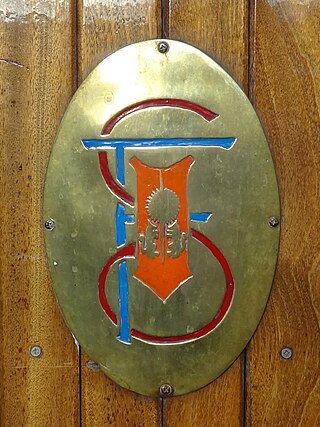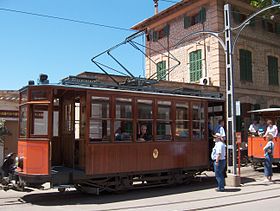
Transport in Spain is characterised by an extensive network of roads, railways, rapid transit, air routes, and ports. Its geographic location makes it an important link between Europe, Africa, and the Americas. Major forms of transit generally radiate from the capital, Madrid, located in the centre of the country, to link with the capitals of the autonomous communities.

Rail transport in Spain operates on four rail gauges and services are operated by a variety of private and public operators. The total route length in 2012 was 16,026 km.

The Barcelona Metro is a network of rapid transit electrified railway lines that run mostly underground in central Barcelona and into the city's suburbs. It is part of the larger public transport system of Barcelona, the capital of Catalonia, Spain, with unified fares under the Autoritat del Transport Metropolità (ATM) scheme. As of 2014, the network is operated by two separate companies: Transports Metropolitans de Barcelona (TMB) and Ferrocarrils de la Generalitat de Catalunya (FGC). It is made up of 12 lines, combining the lines owned by the two companies. Two lines, L9 and L10, are being built at present, with both lines having different sections of each opened between 2009 and 2018. They are due to be fully completed in 2026. Three lines on the network have opened as automatic train operation/driverless vehicle systems since 2009: Line 11, Line 9 and Line 10, in chronological order.

The Seville Metro is an 18-kilometre (11 mi) light metro network serving the city of Seville, Spain and its metropolitan area. The system is totally independent of any other rail or street traffic. All 22 stations were built with platform screen doors.
The 2000–01 La Liga season, the 70th since its establishment, started on 9 September 2000 and finished on 17 June 2001.
The Majorca rail network consists of three separate electrified lines, which radiate north and east from Palma de Mallorca, the major city on the Spanish island of Majorca.
Alvia is a high-speed train service in Spain used by Renfe Operadora for long-distance service with a top speed of 250 km/h (160 mph). The trains have the ability to use both Iberian gauge and standard gauge, which allows them to travel on the recently constructed high-speed lines for part of the journey before switching to the "classic" Iberian gauge network to complete it. Trains that run exclusively on high-speed tracks are branded AVE or Avant.
The 1997–98 Copa del Rey was the 96th staging of the Copa del Rey.
The 2010–11 Copa del Rey was the 109th staging of the Copa del Rey. The competition began on 21 August 2010 and ended on 20 April 2011 with the final, held at the Estadio Mestalla in Valencia, in which Real Madrid lifted the trophy for the eighteenth time in their history with a 1–0 victory over Barcelona in extra time. Sevilla were the defending champions, but they were defeated by Real Madrid in the semi-finals.
The 2011–12 Copa del Rey was the 110th staging of the Copa del Rey. The competition began on 31 August 2011 and ended on 25 May 2012 with the final, which was held at the Vicente Calderón Stadium in Madrid. Entering the competition, the winners were assured of a place in the group stage of the 2012–13 UEFA Europa League. Real Madrid were the defending champions, but were eliminated by Barcelona in the quarter-finals, who went on to win the title.
The 1987–88 Copa del Rey was the 86th staging of the Copa del Rey. The trophy was won by FC Barcelona after beating defending champions Real Sociedad 1–0 in the final.
The 1984–85 Copa del Rey was the 83rd staging of the Spanish Cup, the annual domestic football cup competition in Spain. The tournament was attended by 142 teams from the higher echelons of Spanish football.
The 1990–91 Copa del Rey was the 89th staging of the Spanish Cup. The competition began on 5 September 1990 and ended on 29 June 1991 with the final.

The Tranvía de Sóller is a Spanish heritage tramway serving the town of Sóller and the coastal village of Port de Sóller, in the island of Majorca. It is owned by Ferrocarril de Sóller S.A. (FS), the same company operating the heritage rail line linking the town to the city of Palma.
Traditionally, the gauge of the national railway in Spain, now managed by Adif, is 1,668 mm, known as Iberian gauge. This gauge was decided upon by a Parliamentary committee, after a report known as the Informe Subercase in 1844. Spain has 11,791 km of track with this gauge.
The 2015–16 Copa del Rey was the 114th staging of the Copa del Rey. Going into the tournament, the winners were assured a place for the 2016–17 UEFA Europa League Group stage. However, since the two finalists, Barcelona and Sevilla, both qualified for the 2016–17 UEFA Champions League, respectively by winning the 2015–16 La Liga title and the 2015–16 Europa League, the cup winner's place in the 2016–17 Europa League group stage instead passed to the fifth-place team in La Liga, Athletic Bilbao.
The 1982–83 season was Atlético Madrid's 42nd season since foundation in 1903 and the club's 38th season in La Liga, the top league of Spanish football. Atlético competed in La Liga, and the Copa del Rey.
The 2020–21 season was the 84th season in the existence of RCD Mallorca and the club's fourth consecutive season in the top flight of Spanish football. In addition to the domestic league, Mallorca participated in this season's editions of the Copa del Rey and the UEFA Intertoto Cup. The season covers the period from 1 July 2000 to 30 June 2001.
In the 1997–98 season Real Club Deportivo Mallorca competed in La Liga and Copa del Rey.








